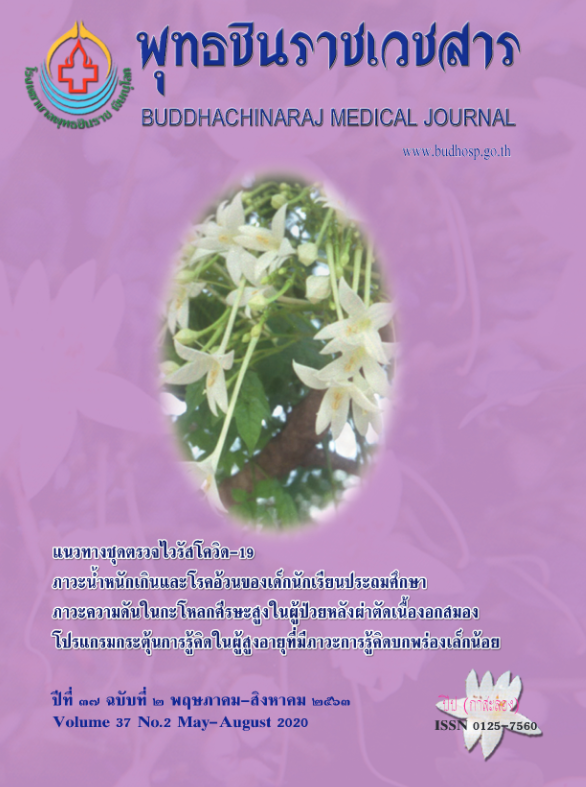ความชุกและปัจจัยที่เกี่ยวข้องกับภาวะน้ำหนักเกินและโรคอ้วนของเด็กนักเรียนประถมศึกษา
ภาวะน้ำหนักเกินและโรคอ้วนของเด็กนักเรียนประถมศึกษา
คำสำคัญ:
เด็กนักเรียนประถมศึกษา, ดัชนีมวลกาย, ภาวะน้ำหนักเกิน, โรคอ้วน, ความชุกบทคัดย่อ
ปัจจุบันโรคอ้วนในเด็กมีความชุกสูงขึ้นทั่วโลก การวินิจฉัยโรคอ้วนในเด็กควรวินิจฉัยจากดัชนีมวลกายที่เป็นเกณฑ์สากล แต่เกณฑ์ ดังกล่าวไม่เหมาะสมสำหรับเด็กไทย การศึกษานี้มีวัตถุประสงค์เพื่อศึกษาปัจจัยที่เกี่ยวข้องกับโรคอ้วนจากกิจวัตรประจำวันของเด็ก นักเรียนประถมศึกษา ประเมินความชุกของภาวะน้ำหนักเกินและโรคอ้วนของเด็กนักเรียนดังกล่าว เปรียบเทียบความแม่นตรง ระหว่างการวินิจฉัยจากเกณฑ์ดัชนีมวลกาย (2000 IOTF) กับ ค่าร้อยละของน้ำหนักอ้างอิงตามเกณฑ์ส่วนสูง โดยศึกษาแบบตัด ขวางในนักเรียนโรงเรียนประถมศึกษาเขตเทศบาล จ.พิษณุโลก จำนวน 694 คน โดยการชั่งน้ำหนัก วัดส่วนสูงของเด็ก และให้ผู้ ปกครองตอบแบบสอบถามเกี่ยวกับกิจวัตรประจำวัน พบปัจจัยที่เกี่ยวข้องกับโรคอ้วนในเด็ก คือ เพศหญิงกับการกินขนมขบเคี้ยว และน้ำหวานระหว่างวัน (p = 0.010 และ 0.031 ตามลำดับ) พบความชุกของภาวะน้ำหนักเกินจากเกณฑ์ดัชนีมวลกายร้อยละ 14.3, โรคอ้วน ร้อยละ 11.2 ขณะที่เมื่อใช้เกณฑ์น้ำหนักอ้างอิงตามเกณฑ์ส่วนสูงพบภาวะน้ำหนักเกินร้อยละ 14.3, โรคอ้วนร้อยละ 11.5 ซึ่งเกณฑ์ทั้งสองให้ผลการวินิจฉัยที่แม่นตรงกันในระดับดีมาก (kappa = 0.86) สรุปได้ว่าโรคอ้วนเกี่ยวข้องกับกิจวัตรประจำวันและ การวินิจฉัยโรคอ้วนในเด็กไทยด้วยเกณฑ์สากลพบความชุกใกล้เคียงกับการวินิจฉัยด้วยเกณฑ์น้ำหนักอ้างอิงตามเกณฑ์ส่วนสูง ซึ่ง สามารถใช้เป็นข้อมูลประกอบการจัดทำแนวทางป้องกันโรคอ้วนในเด็กต่อไป
เอกสารอ้างอิง
2. Obesity: Preventing and managing the global epidemic. Report of a WHO consultation. World Health Organ Tech Rep Ser 2000;894:i-253.
3. Collaborators GBDO, Afshin A, Forouzanfar MH, Reitsma MB, Sur P, Estep K, et al. Health effects of overweight and obesity in 195 countries over 25 years. N Engl J Med 2017;377(1):13-27.
4. Ogden CL, Carroll MD, Lawman HG, Fryar CD, Kruszon-Moran D, Kit BK, et al. Trends in obesity prevalence among children and adolescents in the United States, 1988-1994 through 2013-2014. JAMA 2016;315(21):2292-9.
5. Jitnarin N, Kosulwat V, Rojroongwasinkul N, Boonpraderm A, Haddock CK, Poston WS. Prevalence of overweight and obesity in Thai population: Results of the National Thai Food Consumption Survey. Eat Weight Disord 2011;16(4):e242-9.
6. Gupta N, Goel K, Shah P, Misra A. Childhood obesity in developing countries:Epidemiology, determinants, and prevention. Endocr Rev 2012;33(1):48-70.
7. Power C, Lake JK, Cole TJ. Measurement and long-term health risks of child and adolescent fatness. Int J Obes Relat Metab Disord 1997;21(7):507-26.
8. Styne DM, Arslanian SA, Connor EL, Farooqi IS, Murad MH, Silverstein JH, et al. Pediatric obesity-assessment, treatment, and prevention: An Endocrine Society Clinical Practice Guideline. J Clin Endocrinol Metab 2017;102(3):709-57.
9. Cole TJ, Bellizzi MC, Flegal KM, Dietz WH. Establishing a standard definition for child overweight and obesity worldwide:international survey. BMJ 2000;320(7244):1240-3.
10. Yamborisut U, Mo-Suwan L. Prevalence of childhood and adolescent obesity in Thailand: A review. J Med Assoc Thai 2014; 97(1):44-51.
11. Wayne W. Biostatistics: A foundation of analysis in the health sciences. New York:John Wiley & Sons, Inc; 1995.
12. Ludwig DS, Peterson KE, Gortmaker SL. Relation between consumption of sugarsweetened drinks and childhood obesity:A prospective, observational analysis. Lancet 2001;357(9255):505-8.
13. Malik VS, Pan A, Willett WC, Hu FB. Sugarsweetened beverages and weight gain in children and adults: A systematic review and meta-analysis. Am J Clin Nutr 2013; 98(4):1084-102.
14. Wang YC, Bleich SN, Gortmaker SL. Increasing caloric contribution from sugar-sweetened beverages and 100% fruit juices among US children and adolescents, 1988-2004. Pediatrics 2008;121(6):e1604-14.
15. Juliusson PB, Eide GE, Roelants M, Waaler PE, Hauspie R, Bjerknes R. Overweight and obesity in Norwegian children: Prevalence and socio-demographic risk factors. Acta Paediatr 2010;99(6):900-5.
16. Veugelers PJ, Fitzgerald AL. Prevalence of and risk factors for childhood overweight and obesity. CMAJ 2005;173(6):607-13.
17. Mo-Suwan L, Nontarak J, Aekplakorn W, Satheannoppakao W. Computer game use and television viewing increased risk for overweight among low activity girls: Fourth Thai National Health Examination Survey 2008-2009. Int J Pediatr 2014;2014:364702.doi.org/10.1155/2014/364702
18. Jiang F, Zhu S, Yan C, Jin X, Bandla H, Shen X. Sleep and obesity in preschool children. J Pediatr 2009;154(6):814-8.
19. Rattanachuake S, Thaweekul P, Iamopas O, Suthutvoravut U. The 2014 clinical practice guideline management of childhood obesity [Internet]. 2014 [cited 2015 Dec 1]. Available from: http://www.thaipediatrics.org/cpg_file/CPGobesity_27_1_2015-.pdf
20. Garawi F, Devries K, Thorogood N, Uauy R. Global differencies between women and men in the prevalence of obesity: Is there an association with gender inequality?. Eur J Clin Nutr 2014;68(10):1101-6.
21. Kanter R, Caballero B. Global gender disparities in obesity: A review. Adv Nutr 2012;3(4):491-8.
22. Hart CN, Carskadon MA, Considine RV, Fava JL, Lawton J, Raynor HA, et al. Changes in children's sleep duration on food intake, weight, and leptin. Pediatrics 2013;132(6):e1473-80.
23. Rerksuppaphol S, Rerksuppaphol L. Prevalence of overweight and obesity among school children in suburb Thailand defined by the International Obesity Task Force Standard. J Med Assoc Thai 2010;93(Suppl 2):S27-31.
24. Nonboonyawat T, Pusanasuwannasri W, Chanrat N, Wongthanavimok N, Tubngern D, Panutrakul P, et al. Prevalence and associates of obesity and overweight among school-age children in a rural community of Thailand. Korean J Pediatr 2019;62(5):179-86.
25. Langendijk G, Wellings S, van Wyk M, Thompson SJ, McComb J, Chusilp K. The prevalence of childhood obesity in primary school children in urban Khon Kaen, northeast Thailand. Asia Pac J Clin Nutr 2003;12(1):66-72.
26. Mo-suwan L, Geater AF. Risk factors for childhood obesity in a transitional society in Thailand. Int J Obes Relat Metab Disord 1996;20(8):697-703.
27. Collaboration NCDRF. Worldwide trends in body-mass index, underweight, overweight, and obesity from 1975 to 2016: A pooled analysis of 2,416 population-based measurement studies in 128.9 million children, adolescents, and adults. Lancet 2017;390(10113):2627-42.
28. Skinner AC, Ravanbakht SN, Skelton JA, Perrin EM, Armstrong SC. Prevalence of obesity and severe obesity in US children, 1999-2016. Pediatrics 2018;141(3):1-9.
29. Janssen I, Katzmarzyk PT, Boyce WF, Vereecken C, Mulvihill C, Roberts C, et al. Comparison of overweight and obesity prevalence in school-aged youth from 34 countries and their relationships with physical activity and dietary patterns. Obes Rev 2005;6(2):123-32.
30. Fu WP, Lee HC, Ng CJ, Tay YK, Kau CY, Seow CJ, et al. Screening for childhood obesity: International vs population-specific definitions. Which is more appropriate?. Int J Obes Relat Metab Disord 2003;27(9):1121-6.
31. Neovius M, Linne Y, Barkeling B, Rössner S. Discrepancies between classification systems of childhood obesity. Obes Rev 2004;5(2):105-14.
32. Flegal KM, Ogden CL, Yanovski JA, Freedman DS, Shepherd JA, Graubard BI, et al. High adiposity and high body mass indexfor-age in US children and adolescents overall and by race ethnic group. Am J Clin Nutr 2010;91(4):1020-6.






